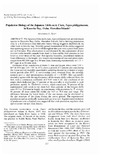Population biology of the Japanese little-neck clam, Tapes philippinarum, in Kaneohe Bay, Oahu, Hawaiian Islands
- Global styles
- MLA
- Vancouver
- Elsevier - Harvard
- APA
- Help

Download URL
scholarspace.manoa.hawaii.edu日付
1977Page views
2,021ASFA keyword
Taxonomic term
Metadata
アイテムの詳細レコードを表示する
Share
抄録
The Japanese little-neck clam, Tapes philippinarum, an introduced species in Kaneohe Bay, Oahu, Hawaiian Islands, has a thriving population only in a U5-hectare mud flat after heavy fishing triggered depletion in six other beds within the bay. Monthly gonad examination of the clams suggested that spawning occurs at a low level throughout the year with a peak from January to February. This observation is corroborated by the appearance of new recruits in the monthly sample from April to June and by their presence at low levels at other times of the year. Size-specific fecundity, determined indirectly from differences in the length: dry weight relationships of ripe and spent clams, ranges from 432,000 eggs in a 20-mm clam, increasing exponentially to 1.35 x 106 eggs in a 40-mm clam.
Estimates of the population of clams 11 mm and larger, which were 3.09 x 106 in 1970 and 3.4 x 106 in 1972, show a growth of 5 percent per year during the 2-year period; monthly quantitative sampling showed no evidence of population growth after 1972. A survivorship curve obtained from the monthly samples gave a total instantaneous mortality of z = 0.2005. The age-specific mortality agrees with the age-frequency of the empty shells collected from the bed, with a correlation coefficient of 0.9345 with 4 d.f. The condition of the empty shells indicated that 57 percent of the mortality is attributable to crab predation, mainly by Thalamita crenata, which constitutes 70 percent of the experimental crab catch in the clam bed. Sixty percent of the broken shells were 19.5 to 30.4 mm in length; in experiments with predation by T. crenata, 96 percent of those eaten fell within the 14.5 to 30.4 mm size range. The difference between the lower limits of the size ranges can be attributed to the size structure of the clams during the survey period. The experimental population had an artificially maintained size structure. Experimental exclusion of predators over a limited area suggested that crab predation regulates clam size structure but not clam density.
Suggested Citation
Yap, W. G. (1977). Population biology of the Japanese little-neck clam, Tapes philippinarum, in Kaneohe Bay, Oahu, Hawaiian Islands. Pacific Science , 31(3), 223-244. http://hdl.handle.net/10862/1066
Type
ArticleISSN
0030-8870Collections
- Journal Articles [1229]


